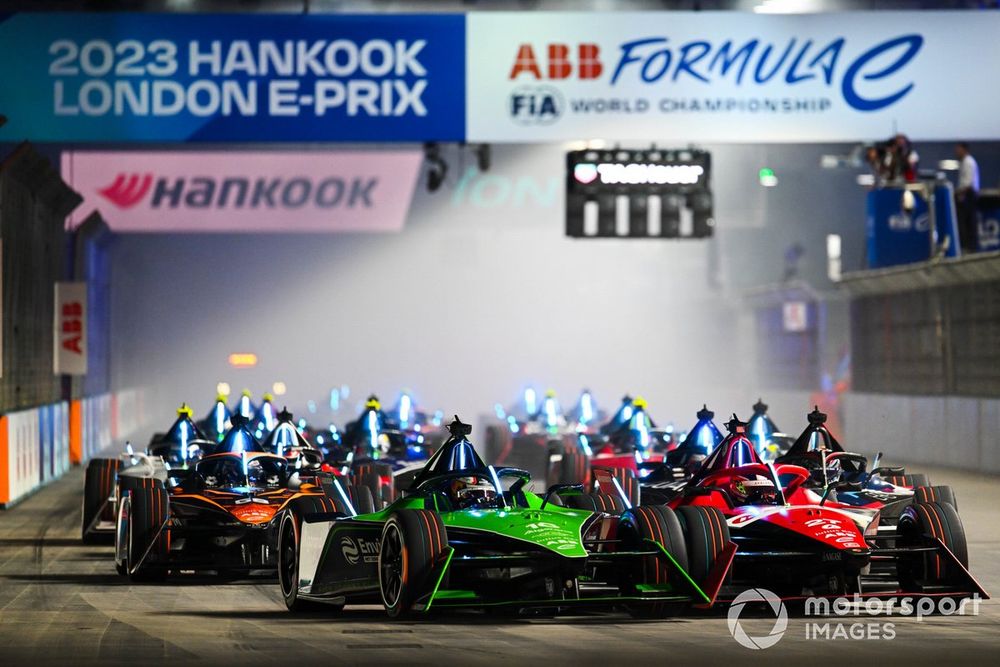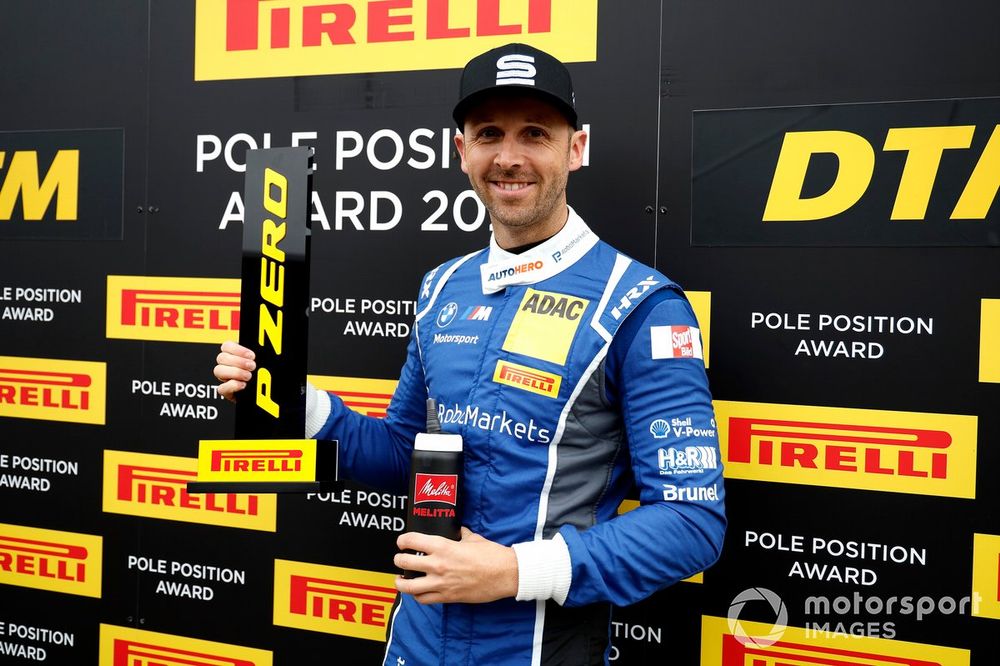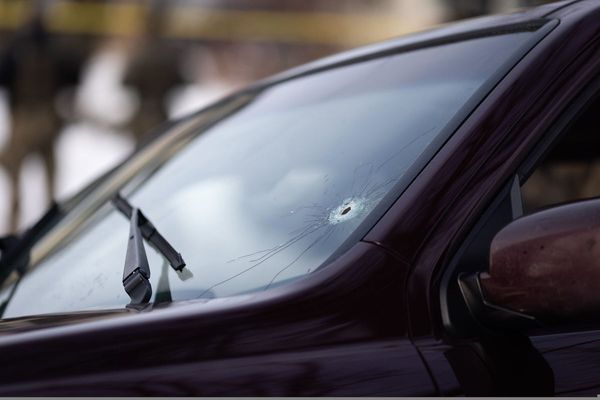
The dramatic sight of Damon Hill’s Bridgestone-shod Arrows overtaking the Goodyear-rubbered Ferrari of old rival Michael Schumacher for the lead in the 1997 Hungarian Grand Prix is one of the enduring images of the decade in Formula 1. For a different reason, so was the sight of Schumacher, now with Bridgestones on his Prancing Horse, leading away a grid of six cars at Indianapolis in 2005 after the withdrawal of Michelin’s runners on safety grounds.
Tyre wars have been missing from F1 since Michelin’s departure at the end of 2006. Long-serving Bridgestone engineer Kees van der Grint regards it as a seminal moment in recent motorsport history because, in the years since, competition between tyre companies has been slowly disappearing from categories around the world.
“Some team bosses complained – and were obviously not the team bosses on Bridgestone – that they had the best car but, because they had no control over the tyre, they could not win,” the Dutchman recalls. “The lobby was strong, and then it all changed. Michelin wanted a challenge, they pulled out because they didn’t want one-make tyres, they wanted to beat Bridgestone.”
Super GT in Japan, the European Rally Championship, and the Nordschleife-based NLS endurance series are increasingly outliers among the herd as most leading series on the international and national level today have single-supplier deals, with many unwilling to ever countenance tyre competition. Formula E has followed this model since its inception when it partnered with Michelin, before Hankook took over for the Gen3 cars.
“Definitely we’re not interested in a tyre war,” insists FE co-founder Alberto Longo. “We’re way more interested in a sporting equality. Having two sets of tyres, coming from two different manufacturers, the tyre could give you three seconds’ advantage. That would go, in my point of view, against the sporting equity of any sporting property.”
Another series formed in 2014, the World Rallycross Championship, has also been single-supplier since the outset. With the Melksham manufacturing plant of its long-term partner Cooper scheduled to close down at the end of this year, change is imminent, but series coordinator Tim Whittington is adamant that “it will still be a single-supply deal”. Cost and sustainability are cited as “the two biggest items” behind that stance.

To van der Grint, a key player in Schumacher’s title-winning armoury during Ferrari’s pomp, the gradual decline of tyre wars is cause for regret. Describing himself as a “big fan of competition”, he points to Hill’s surprise emergence in Hungary in 1997 as an example of the benefits it can bring, and reasons that competing suppliers in F1 2023 “would be great for the sport” by introducing greater unpredictability.
“I don’t think a tyre competition would damage the show at all,” he asserts.
But, as FIA director of circuit sport Marek Nawarecki points out, the on-track show makes up only a fraction of the criteria when deciding whether or not to have a tyre war. “It’s not only what we see on the track which is the full picture,” he argues.
The upsides of a monopoly
For British Touring Car Championship boss Alan Gow, there are considerable upsides to ditching tyre competition. Its exclusive contract with Goodyear until the end of 2026 allows organising body TOCA to subsidise the cost of rubber. He jokes that “the only thing [teams] never whinge about is the price of tyres”.
"The car was running basically three days a week. I would not say 52 weeks but a lot of time. And this is the expense in tyre competition, because I presume Michelin did the same" Kees van der Grint
It follows that jettisoning a tyre war from a championship is a straightforward means of saving costs and cutting down the production of rubber. When tyre competition is ditched, Nawarecki says “the benefits in terms of costs and sustainability are massive”.
“Ask a team the number of tests they had to perform in this situation in the past with the tyre wars compared to the current situation, ask the tyre manufacturer the number of tyres they used in this situation of tyre wars – it’s not comparable,” the former deputy team principal of Citroen’s World Rally Championship operation adds.
Today’s restrictions on testing limit the ability of teams and their partners to fine-tune a bespoke tyre in the way Ferrari and Bridgestone did 20 years ago. Van der Grint concedes that this was both labour and cost-intensive.

“The car was running basically three days a week,” he says. “I would not say 52 weeks but a lot of time. And this is the expense in tyre competition, because I presume Michelin did the same. Most of the time on the Friday we decided which spec to use for the next race, and they were produced in a small quantity, in this case only for Ferrari, shipped out on Monday or Tuesday and then fitted on Thursday for first practice on Friday. Of course, everything was air-freighted.”
Once it is no longer fixated on beating a competitor, a single tyre manufacturer is freed up to focus on the bigger picture and find a better balance between performance and durability. As Nawarecki puts it: “When you have the tyre war, it’s clear that everybody will go on the performance side.”
Goodyear’s position as the sole approved LMP2 tyre supplier has given it scope to slash the number of compounds it brings to every World Endurance Championship race. The company has developed a single slick-tyre specification capable of working across the full threshold of temperatures, from 40C in Bahrain to 4C at Spa, and ditched its intermediate offering to instead present teams with a single wet option that boasts a wider working window. Endurance programme manager Mike McGregor says that this results in a handy reduction in the company’s overall footprint when freighting tyres around the globe, while also levelling the competitive playing field.
“When people have this multiple choice, they feel that they can gain an advantage here or there,” states McGregor. “But also they can gain a disadvantage by making the selection at the wrong time. So us bringing tyres that perform better in these windows and by having less choice means they can be on the right product at the right time.”
Having a single supplier also makes it easier to lay down rules governing the number of tyre sets that can be used per weekend. Former Autosport correspondent Whittington recalls days where rallycross events got out of control.
“It wasn’t that uncommon for the people with the biggest budgets to be burning through half a dozen sets of tyres, which is clearly ridiculous when you’re doing 40 or 50 kilometres in an event,” he says. “They would use new tyres at every four-lap race. Every single heat race they would just put new tyres on, especially on a dry, hot day maybe on an abrasive track.”
For a promoter, there are clear commercial upsides to working with a single supplier too. Even at the peak of its manufacturer involvement, the DTM shied away from tyre competition, instead partnering with Dunlop, then Hankook, Michelin and now Pirelli. It’s now a rebooted GT3 series for customer teams under the control of the ADAC and its motorsport director Thomas Voss says: “It’s much easier to do all the marketing and activation things with one supplier than if you have two or three different.”
When it comes to choosing between development and advertising, for a business-savvy promoter there can only be one winner.

Are tyre wars all that bad?
Safety, clearly, is one of a tyre’s primary purposes as the only contact between the car and the road. But van der Grint is adamant that the farcical scenes at Indianapolis in 2005 “had nothing to do with a tyre war” and was merely a product of Michelin taking “too much risk” by taking two competitive specs that weekend. After all, he points out in a thinly veiled reference to Pirelli’s difficult task to meet F1’s mandate for fast-degrading tyres, “even with one-make tyres, as we have seen over the years, you can have a problem”.
Van der Grint maintains that the 2005 F1 season, when regulations required tyres to last a full race distance, serves as proof that sustainability and tyre wars can still go hand-in-hand. “As long as the rulemaker writes good rules” that emphasise sustainability, he believes there should be no issues with tyre competition, particularly since improvements in simulation mean a greatly reduced reliance on track testing. For instance, Michelin developed its 2021 WEC Hypercar tyres entirely in the virtual realm.
By the same token, van der Grint points out that single-supplier deals don’t necessarily result in increased sustainability where tyres take on a primarily tactical purpose. He declares F1’s current approach, which involves the production and transportation of three compounds per weekend, with the softest usually reserved for qualifying, as “a waste of energy, a waste of rubber, a waste of resources” that “makes no sense anymore”. Would F1 teams have been more willing to accept a move to running without tyre blankets in 2024, which Pirelli had been pushing hard on, if competing suppliers had been ploughing resources into the matter?
"The spectators don’t see the development in the tyres, they are still black and round since 200 years! They don’t take so much care about the technology and the differences between the tyres" Thomas Voss
“Many people criticise Pirelli about the product, but nobody knows exactly if the tyre is bad or if the tyre is really good,” van der Grint reckons. “You can only judge that if there is another one. I do not understand why chassis designers can compete with each other, engine manufacturers can compete with each other, and why tyre manufacturers are not allowed to compete with each other.”
Van der Grint also rejects the view that increasing car speeds necessitate a control supplier, with grooved tyres an effective means of achieving this. “There is always a way by the rulemaker, if they want, to make the tyres for the car go slower, but that is not a reason to stop,” he insists. “Give the tyre manufacturer a challenge and with that challenge, like it was with the grooved tyre, you can control more or less the speed.”
But is there any way back?

Why it’s not going to change
Tyres rank fairly low on a list of priorities for a promoter to cultivate a perception of their series as being forward-thinking, especially given the current landscape, where alternative powertrains are all the rage. DTM gatekeeper Voss says tyres aren’t of interest to most enthusiasts, for whom it’s merely “a black, round thing”, and that apathy means it’s not worth losing the benefits that result from a single-supplier relationship.
“The spectators don’t see the development in the tyres, they are still black and round since 200 years!” he laughs. “They don’t take so much care about the technology and the differences between the tyres.”
Voss believes a tyre war in the DTM would only make sense “if some time there would be a real different type of tyres” to showcase, but adds: “I don’t see this development at the moment.” Even if the sustainable content of tyres was increased to a point close to 100%, it would require tightly written rules to prevent manufacturers increasing the number of tyres taken to events to avoid undermining the very sustainable credentials they seek to promote.
It’s difficult to see a way back for tyre wars in sportscar racing, which is reliant upon Balance of Performance to secure manufacturer participation. Nawarecki points out that in the context of the WEC it “would be completely impossible to manage” BoP with a tyre war. In such a circumstance, the WEC “would be a completely different championship”.
“We know that one of the reasons that we have today seven manufacturers in Hypercar, and hopefully we’ll have even more next time, is because we, together with all the stakeholders, managed to have a category which is pretty much cost-controlled,” he relates.
The very fact that so many series are now single-supplier is also driving down participation in open competition forums. In its decision to withdraw from the Japanese series at the end of this season, Michelin cited the reduced relevance of Super GT as a laboratory for the WEC since Hypercar became a single-supplier category, with Bridgestone left to fight against a small contingent from Yokohama and Dunlop from 2024.
“To spend money just to beat Bridgestone, Yokohama… it’s fun, but it doesn’t have much value,” points out Michelin motorsport director Matthieu Bonardel. “We are not going to sell more tyres, because Japan is not a big market for us, and we won’t learn things we can use in endurance racing.”
And in those series that do still welcome tyre competition, the model isn’t easily transplantable elsewhere.

WRC Promoter’s senior sporting director Peter Thul is adamant that the world championship won’t go back to open tyre competition, with only one supplier since DMACK stepped back at the end of 2017. But he’s happy to see different suppliers in sister series the ERC – Hayden Paddon won the 2023 title on Pirellis against competitors using Michelin, Hankook and MRF, which operates its own squad – because many of its entrants are drawn from national series.
For Thul, “it’s a championship dedicated to professional privateers plus maybe some importer teams, so it’s a complete different story to the factory-run cars in the WRC.”
Do we miss anything?
Although it might mix up the F1 pecking order from time to time, there’s uniform consensus that reintroducing tyre competition into other disciplines wouldn’t improve the show. The primary purpose of rallycross, Whittington acknowledges, is “for entertainment rather than racing to develop new technologies”. As a result, he says “there’s not really a huge amount of point in every team having a tyre technician trying to optimise which tyre to run in which condition”.
"Having one spec rather than two different tyre manufacturers means you’ve got the quality of competition, but everyone runs on the same tyre, so no one has got a better tyre. It’s fairer if they all run on the same tyre" Alan Gow
“It’s about delivering good racing and not being too bogged down in the engineering detail,” he adds. “When tyre choice is free, you see the people with the biggest budgets buying an advantage and that’s rarely good for the entertainment.”
Gow is in no doubt that tyre wars don’t benefit the competition because “inevitably, one tyre dominates”. As a result, he’s clear that it won’t be coming back to the BTCC for the first time since 1998, when Audi ditched its Dunlops and joined the rest on Michelins at the height of the Super Touring era.
“It’s never equity,” says Gow. “When you’ve got competition, one tyre company will hoover up the top teams and then leave the other tyre company to do otherwise, and that’ll mean that tyre company will go out of the championship in another year or two because they realise they have no chance of winning.
“Having one spec rather than two different tyre manufacturers means you’ve got the quality of competition, but everyone runs on the same tyre, so no one has got a better tyre. It’s fairer if they all run on the same tyre.”

While clearly the loss of tyre wars changes an engineer’s outlook – van der Grint admits that “I didn’t like it at all” when he became Bridgestone’s head of track engineering to service all F1 teams in 2007 – the job satisfaction of engineers is not a determining criteria for the health of a series. That comes from teams and manufacturers filling grids each year.
Goodyear’s McGregor concedes that “there’s an excitement from the tyre war” in sportscars, having previously worked on Dunlop’s motorsport programmes competing against Michelin in LMP2, and in GTE Pro with Aston Martin. But he reasons that “as an overall benchmark for a championship and from a fan perspective, it’s much easier to understand without tyre wars”.
“As a pure engineering enthusiast – someone who is really involved in the detail – I can see where they would see plus points in a tyre war,” he says. “Looking at a general competitor point of view, I see a huge benefit to not having tyre wars.
“In terms of equality across the grid, in terms of making more competitors competitive in the same arena to create overall better racing, I think LMP2 is testament to that. You look at the last few years and at the end of Le Mans they’re still racing each other after 24 hours. It doesn’t matter which car you are, you can extract the same levels of performance out of the tyres. Nobody is turning up and winning every single race.”
Tyre wars have largely become a thing of the past. Whichever side of the fence you’re on, it seems there’s no going back.

Driver’s View
You might expect that drivers would welcome tyre wars since intensive development in rubber generally results in faster lap times. But, for Peter Dumbreck, who spent four years in Super GT with Kraft Toyotas and contested the Nurburgring 24 Hours 14 times for the racing arm of Japanese tyre company Falken, there are plenty of frustrating complications too.
The Scot recalls his first Super GT test at Fuji in 2005 with wonderment as a car he’d thought would be comparable to the Opel Vectra he’d raced in the 2004 DTM – both had sequential gearboxes and “decent” downforce – surpassed all expectations. Where the Opel “had a very small window of compliance in the tyre”, in the Toyota “you could play with the car in the corner”.
“I could feel the car stepping out and just control it, it was no big deal,” he remembers. “You’d throw the car in, and it went. You could literally hit the brake as hard as you could, you couldn’t lock the tyres until right near the end of the braking cycle.”
But running on Dunlops meant he was in the minority against the numerically superior Bridgestones: “We got so many sets of tyres thrown at us and a lot of test days, but essentially you’re always playing catch-up.”
"When you have a tyre war, you’re doing both car set-up and tyre development and the car set-up gets hampered. You’re too busy keeping the car the same so we can actually do tyre development" Peter Dumbreck
Victory at Fuji in 2006 was seen as a breakthrough, but “actually the following year we were nowhere, worse than ever”, which prompted a switch to Bridgestone for 2008. Joining the consistent majority, he recalls, at least “made things more simple”.
“With the Dunlop it was peaky,” Dumbreck explains. “If you got it right, you got it right, but the window of driveability of the car was tiny. If you managed to get in that window, you were one of the quickest cars out there, but sometimes you didn’t know when it was coming!”
As tyre wars become rarer, fewer drivers will get to build up the same knowledge base. Dumbreck is “glad to have experienced that feeling”, and knows it expanded his horizons. But he reckons he “spent too long in underdog teams” in the second half of his career, with the imbalance between his performances and results due to the tyres now a cause for regret.
“I don’t think as a driver you lose from not having tyre wars, because you transfer all your time into car set-up,” Dumbreck concludes. “When you have a tyre war, you’re doing both car set-up and tyre development and the car set-up gets hampered. You’re too busy keeping the car the same so we can actually do tyre development.”
Additional reporting by Stefan Mackley, Marcus Simmons, Jamie Klein and Tom Howard








